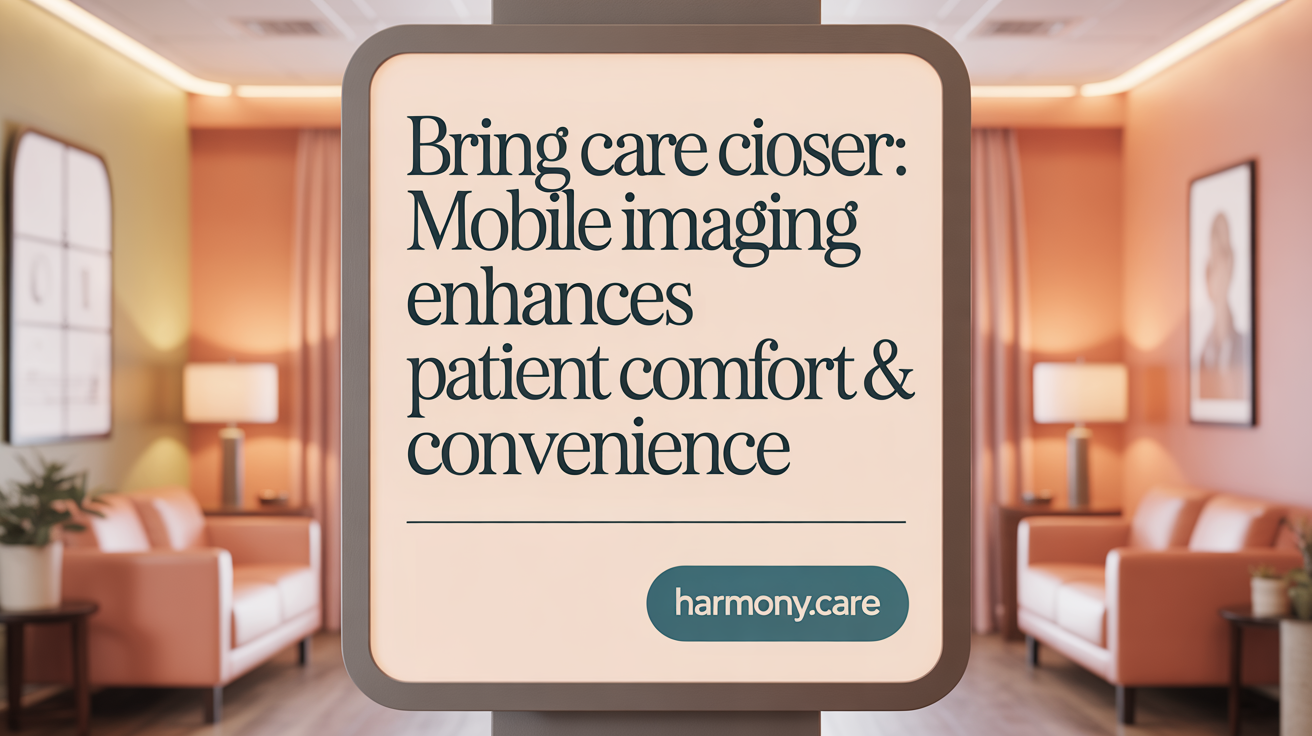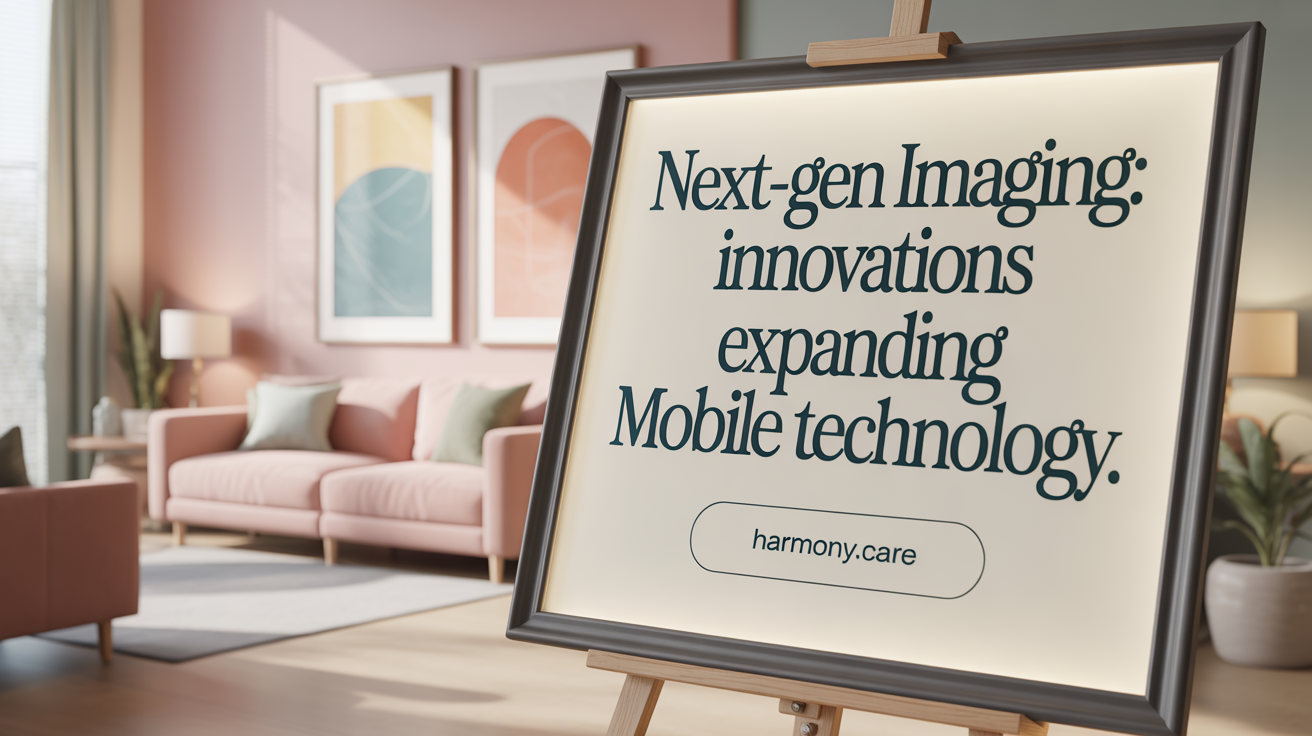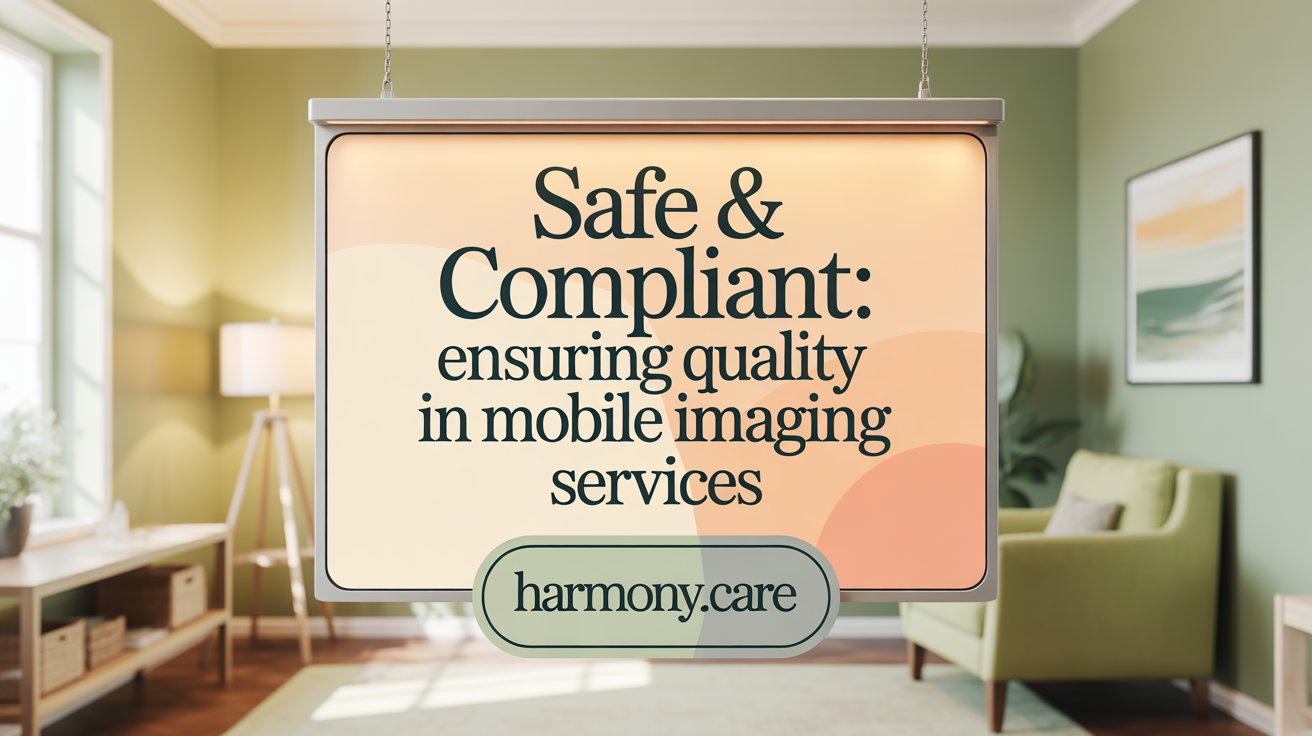Opening the Door to Advanced Care at Home
Mobile imaging technology is rapidly revolutionizing home healthcare by delivering high-quality diagnostic services directly to patients’ doorsteps. It offers an innovative way to overcome traditional barriers such as mobility challenges, geographic limitations, and hospital overcrowding. This article explores how mobile imaging serves as a critical advancement in healthcare, benefiting patients, providers, and the broader healthcare system.
Enhancing Patient Care with Mobile Imaging Technology

How does medical imaging benefit patient care?
Medical imaging plays a vital role in transforming patient care by offering quick and precise visualization of internal structures within the body. Techniques such as X-rays, ultrasounds, and EKGs allow healthcare providers to diagnose health issues accurately, even in complex cases.
One major advantage is early detection. Mobile imaging enables screenings to happen on-site, whether at a patient's home, nursing home, or remote clinics, reducing the wait time between hospital visits and initial assessment. This immediate access speeds up diagnoses, allowing for faster intervention and treatment plans.
In addition, mobile imaging services improve safety and comfort for vulnerable groups like the elderly or critically ill patients. Patients can stay in familiar environments without the stress of traveling to imaging centers, which minimizes risks associated with transfers and repeated hospital visits.
By integrating advanced imaging into routine or emergency care, healthcare providers can enhance diagnostic accuracy. This supports tailored treatments, monitoring of disease progression, and optimizes health outcomes overall.
How mobile imaging improves accuracy and early detection
Mobile imaging units equipped with digital technology and AI tools create opportunities for prompt detection of abnormalities such as fractures, tumors, infections, or cardiovascular issues. These devices deliver high-quality images rapidly, with preliminary reports often available within hours.
In critical situations, immediate access to imaging enables clinicians to make informed decisions at the point of care. For example, in emergency scenarios, portable X-rays can identify life-threatening conditions like pneumothorax or internal bleeding on the spot.
Furthermore, early detection through mobile diagnostics allows timely intervention, which can prevent complications, reduce hospital stays, and enhance recovery prospects.
Application of X-ray, ultrasound, and EKG in home care
X-ray, ultrasound, and EKG are vital tools within the mobile imaging spectrum, especially valuable in home and community settings. Portable X-ray units help detect bone fractures, lung infections, or post-surgical complications without requiring patient transportation.
Mobile ultrasounds provide real-time imaging of abdominal organs, blood flow, and soft tissues, aiding in diagnosing conditions like aneurysms or organ damage. Ultrasound's portability and safety make it suitable for bedside assessments or in remote locations.
EKGs monitor heart activity instantly, crucial for diagnosing cardiac problems in patients who cannot easily visit clinics. Mobile EKG devices enable continuous heart monitoring and facilitate early detection of arrhythmias or ischemic changes.
Role of imaging in guiding treatment planning
Imaging results are fundamental in developing effective treatment strategies. Accurate visualization guides surgeons during procedures, helps determine the extent of disease, and monitors ongoing therapy response.
Mobile imaging enhances this process by providing on-site diagnostics, which allows for immediate treatment adjustments. For example, in post-operative care, ultrasound can assess wound healing, and X-rays can verify the placement of medical devices.
By making high-quality imaging accessible at the patient's location, healthcare providers can streamline decisions, reduce delays, and improve overall treatment efficiency. This approach not only benefits clinical outcomes but also enhances patient satisfaction by delivering care closer to home.
Mobile Radiography: Bringing Hospital-Grade Imaging to the Home

What are the advantages of mobile radiography in home healthcare?
Mobile radiography offers numerous benefits for homebound patients, especially those who are elderly, disabled, or recovering from surgery. By delivering high-quality X-ray, ultrasound, and EKG services directly to patients' homes, it eliminates the need for lengthy and often challenging trips to medical facilities.
This approach greatly enhances convenience and accessibility. Patients no longer need to mobilize and travel, which reduces physical discomfort and potential risks associated with transport. Portable imaging devices are quick to set up, allowing providers to perform assessments efficiently and often receive results within the same day.
Speed is critical in healthcare. Mobile X-ray technology, combined with dedicated software, ensures swift communication of images and preliminary reports, often within 30 to 60 minutes. This rapid turnaround supports quicker diagnosis and treatment planning, especially crucial in emergency or urgent care scenarios.
Reducing visits to hospitals or clinics also minimizes the risk of infections, an important consideration during infectious disease outbreaks like COVID-19. By decreasing patient exposure to crowded environments, mobile radiography enhances safety for vulnerable populations.
The workflow of mobile imaging services is designed for round-the-clock availability, providing flexibility for scheduling and emergencies. This 24/7 access ensures timely diagnostics, reduces wait times, and helps streamline healthcare operations.
Overall, mobile radiography improves patient outcomes by delivering timely, comfortable, and safe imaging services right at home, supporting a more efficient and patient-centered healthcare system.
Accelerating Diagnosis and Treatment Through Fast Feedback

What are the benefits of mobile imaging related to feedback speed and patient treatment?
Mobile imaging significantly enhances healthcare by delivering rapid diagnostic results, often within 30 to 60 minutes, thanks to digital systems and online reporting portals. This quick turnaround allows healthcare professionals to make informed decisions without delay, facilitating prompt treatment. For patients, especially those who are elderly, disabled, or in critical condition, on-site imaging reduces the stress and risks associated with transportation to imaging centers. Patients experience greater comfort and safety when exams are performed in their familiar environments.
Moreover, mobile imaging services are available around the clock, including in emergencies, ensuring that vital diagnoses are not delayed regardless of the time. This continuous availability is essential in urgent situations like suspected fractures, infections, or internal bleeding, where immediate visual data can make a lifesaving difference.
The combined effect of faster feedback and on-the-spot diagnostics streamlines healthcare workflows, minimizes hospital admissions and transfers, and accelerates intervention. Consequently, this quick and accessible imaging approach improves overall patient outcomes, ensures more efficient use of medical resources, and enhances patient satisfaction by reducing wait times and delivering high-quality, timely care.
Innovations and Expanding Applications of Mobile Imaging Devices

Technological advances: AI integration, wireless connectivity, miniaturization
Mobile imaging devices are rapidly evolving thanks to new technological advancements. Artificial Intelligence (AI) is now integrated into many systems to enhance image quality and assist in rapid diagnosis by analyzing scans in real time. Wireless connectivity allows images to be uploaded to cloud platforms instantly, facilitating quick review and collaboration among medical teams. Miniaturization of components has made portable devices more lightweight and user-friendly, enabling healthcare providers to perform scans in various environments without sacrificing image precision.
Applications in remote, emergency, and underserved settings
These innovations are particularly valuable in settings that lack traditional medical infrastructure. Portable X-ray and ultrasound systems now serve populations in remote villages, refugee camps, and disaster zones. They enable rapid diagnosis during emergencies, such as accidents or outbreaks, where time is critical. These devices reduce the need for patient transportation, making healthcare more accessible in underserved areas and during crises.
Role in telemedicine and enhanced patient engagement
As telemedicine expands, mobile imaging plays a vital role. Digital images from portable devices can be shared instantly with specialists for remote consultations, improving diagnostic accuracy and treatment planning. Patients benefit from receiving care in familiar locations, increasing engagement and compliance. This seamless integration accelerates decision-making processes and supports continuous care, especially for chronic disease management.
Use in injury detection, legal documentation, and advanced diagnostics
Mobile imaging is indispensable for injury assessment in legal cases, providing prompt, high-quality evidence for injuries like fractures or soft tissue damage. Its ability to deliver immediate results supports legal and insurance processes. Advancements also extend to sophisticated diagnostics like Alzheimer’s disease and cancer monitoring, where mobile MRI and PET scans help track disease progression without requiring hospital visits.
Recent innovations continue to broaden the scope of mobile imaging, transforming healthcare delivery by making advanced diagnostics accessible, efficient, and patient-centered.
Ensuring Safety, Compliance, and Quality in Mobile Imaging Services

What regulatory frameworks govern mobile imaging?
Mobile imaging providers must adhere to various federal and state regulations to ensure safety and quality. These include guidelines from the Centers for Medicare & Medicaid Services (CMS), which set standards for safety, equipment, and operational procedures. State health departments often require licenses for mobile units, professional certifications for technologists, and regular inspections. Additionally, accreditation from organizations like the American College of Radiology (ACR) or the Joint Commission demonstrates compliance with high-quality care standards.
How is radiation safety and patient confidentiality maintained?
Protecting patients from unnecessary radiation exposure is a top priority. Federal agencies such as the Nuclear Regulatory Commission (NRC) oversee radiation safety protocols, mandating shielding, equipment maintenance, and safety training. Similarly, HIPAA compliance is essential to safeguard patient information. Mobile imaging providers implement secure data handling and encrypted digital transmission of images and reports, ensuring patient confidentiality is maintained during every step.
Why are certified technicians and accredited providers crucial?
Certified technologists ensure that imaging procedures are performed accurately and safely, reducing risks and improving diagnosis quality. Accredited providers meet rigorous standards for operational excellence, safety, and patient care, which enhances trust. These credentials also help providers stay current with technological advancements and safety practices, ultimately leading to higher patient satisfaction and compliance with legal standards.
Why is adherence to standards significant?
Compliance with regulations and safety guidelines not only ensures legal adherence but also guarantees reliable and trustworthy diagnostics. It protects patients from harm, guarantees data confidentiality, and maintains the integrity of medical records. High standards foster confidence among healthcare providers and patients, enabling effective, timely treatment decisions and supporting overall healthcare quality.
| Aspect | Regulatory Agency/Standard | Benefits |
|---|---|---|
| Licensing and Certification | State health departments, CMS | Legal operation, qualified staff |
| Radiation Safety | NRC, state radiation boards | Patient protection, equipment safety |
| Data Privacy | HIPAA | Confidentiality of patient health information |
| Quality Accreditation | ACR, The Joint Commission | High-quality, consistent imaging standards |
Mobile imaging services must integrate these standards seamlessly, ensuring safe, effective, and legally compliant diagnostics across all healthcare settings.
The Transformative Potential of Mobile Imaging in Home Care
Mobile imaging stands as a transformative advancement in home healthcare, drastically improving accessibility, efficiency, and patient comfort. By delivering immediate, high-quality diagnostic services at patients’ locations, it reduces hospital visits and streamlines clinical workflows. Technological innovations continue to enhance its capabilities, broadening its applications across diverse care settings, including emergencies and remote communities. Adherence to stringent safety and regulatory standards ensures patient well-being and data security, making mobile imaging a reliable and essential component of modern healthcare. As demands evolve with aging populations and complex health needs, mobile imaging is poised to significantly enhance patient outcomes and redefine healthcare delivery at home.
References
- The Benefits of Mobile Imaging for Home Health and Hospice
- Benefits of Mobile Imaging Solutions
- Revolutionizing Healthcare: The Rise of Mobile Ultrasound at ...
- The Power of Mobile X-Ray - Saddleback Portable Xray
- Mobile Imaging: Facilitating A Timely Diagnosis And Treatment ...
- The growing demand for imaging services: key trends shaping the ...
- AI in Mobile Imaging: A Game Changer for Post-Surgical Care
- Impact of Mobile X-Rays on Patient Care - Solutions for Tomorrow
- How Digital X-ray Technology Improves Accuracy and Patient Care
